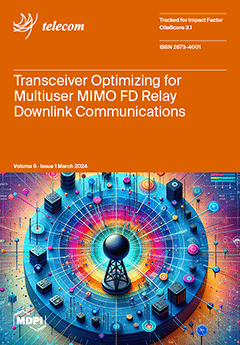6G will connect heterogeneous intelligent agents to make them natively operate complex cooperative tasks. When connecting intelligence, two main research questions arise to identify how artificial intelligence and machine learning models behave depending on
(i) their input data quality, affected by errors induced
[...] Read more.
6G will connect heterogeneous intelligent agents to make them natively operate complex cooperative tasks. When connecting intelligence, two main research questions arise to identify how artificial intelligence and machine learning models behave depending on
(i) their input data quality, affected by errors induced by interference and additive noise during wireless communication;
(ii) their contextual effectiveness and resilience to interpret and exploit the meaning behind the data. Both questions are within the realm of
semantic and
goal-oriented communications. With this paper, we investigate how to effectively share communication spectrum resources between a legacy communication system (i.e., data-oriented) and a new goal-oriented edge intelligence one. Specifically, we address the scenario of an enhanced Mobile Broadband (eMBB) service, i.e., a user uploading a video stream to a radio access point, interfering with an edge inference system, in which a user uploads images to a Mobile Edge Host that runs a classification task. Our objective is to achieve, through cooperation, the highest eMBB service data rate, subject to a targeted
goal effectiveness of the edge inference service, namely the probability of confident inference on time. We first formalize a general definition of a goal in the context of wireless communications. This includes the goal effectiveness, (i.e., the goal achievability rate, or the probability of achieving the goal), as well as
goal cost (i.e., the network resource consumption needed to achieve the goal with target effectiveness). We argue and show, through numerical evaluations, that communication reliability and goal effectiveness are not straightforwardly linked. Then, after a performance evaluation aiming to clarify the difference between communication performance and goal effectiveness, a long-term optimization problem is formulated and solved via Lyapunov stochastic network optimization tools to guarantee the desired target performance. Finally, our numerical results assess the advantages of the proposed optimization and the superiority of the goal-oriented strategy against baseline 5G-compliant legacy approaches, under both stationary and non-stationary communication (and computation) environments.
Full article





